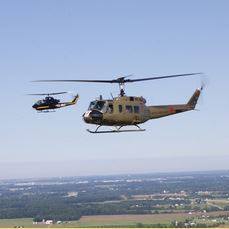
Commemorative Air Force
263607856
Peachtree, GA 30269 USA
commemorativeairforce.org
CAF1957
CommemorativeAF
939858
Podobné organizace
Podobné organizace global
BROOKLANDS MUSEUM TRUST LIMITED |
|
COMOX VALLEY AIR FORCE MUSEUM ASSOCIATION |
|
New Brunswick Aviation Museum, Inc. |
|
NORTHWESTERN ONTARIO AVIATION HERITAGE CENTRE INC. |
|
AD ASTRA FOUNDATION MANAGEMENT LIMITED |
Podobná návštěvnost
Církev adventistů sedmého dne |
|
Pionýr, z. s. |
|
České centrum pro investigativní žurnalistiku, o.p.s. |
|
SK HAMR, z.s. |
|
DOBNET, z.s. |
Podobně sociální sítě (390073)
Charita Lucie Bílé z.s.678000 |
|
Nadační fond Dany a Emila Zátopkových473112 |
|
ZAYFERUS, o.p.s.509000 |
|
Nadace TLAPKA4099999 |
|
Lékaři bez hranic - Médecins Sans Frontiéres in Czech Republic, o.p.s.11011062 |
Novinky
A couple of weeks ago, we told you about the Pratt & Whitney 747SP engine testbed coming to Oshkosh, and it got a big reaction. So today, we wanted to tell you that some of your favorite big aircraft have served in similar roles in the past. Did you know about any of these? During the latter days of World War II into the early Cold War, airframe innovation took on a new urgency — piston‑powered heavy bombers such as the Lancaster, B‑17, B‑24 and even the TBM Avenger were pressed into service as flying engine testbeds, mounting early jet and turboprop engines to accelerate development in the jet age. One remarkable example was a Lancaster converted in 1943 to test Metropolitan‑Vickers F.2 turbojets. This work likely led to the mixed propulsion Lancastrian Airliner, which became the first jet to fly passengers. Another Avro Lancaster, likewise, served as a flying testbed for the Swedish Dovern turbojet hung beneath the fuselage. One was even fitted with an Armstrong-Siddley Mamba turbojet in the nose, and another even had a Rolls-Royce Nene jet installation in the tail. On the American side, the Boeing B‑17 Flying Fortress was at the forefront of turboprop experimentation. In the early 1950s, Pratt & Whitney fitted a T‑34 turboprop engine in the nose of a surplus B‑17, creating the famous “five‑engine B‑17” testbed to evaluate the new powerplant in flight. The aircraft flew from 1950 to the 1960s under Navy and USAF auspices. In total, three B‑17Gs had their noses significantly reworked to accommodate turboprops or jets, sacrificing their front fuselages for engine test data. Even the Consolidated B‑24 Liberator also joined the testing effort after WWII. One B‑24 was outfitted with a prototype jet engine for trials on the side of the fuselage. But as jet test beds go, the TBM Avenger World War II torpedo bomber was perhaps the oddest. Half burying a British Halford H‑1B (de Havilland Goblin) turbojet in the bomb bay, with the exhaust coming out under the belly, this is the program we know the least about. So, if anyone can give us more details in the comments, we'd appreciate it. Altogether, these testbeds tell a story of resourcefulness and transition. Wartime bombers, once the pinnacle of piston‑engine aviation, found new life as platforms that bridged the gap into jet and turboprop propulsion. Each flying laboratory advanced engine designs that would power the next generation of aircraft, transforming roaring radial giants into the powerful whine of turbines that defined postwar flight. (fb)
Tanks don't come up much in WWII aviation circles. But in one of the war’s boldest engineering experiments, Britain managed to fly a tank into combat. This effort began in mid-1942, when the British Army formed an Airborne Light Tank Squadron within the newly established 1st Airborne Division and began adapting the Light Tank Mk VII, better known as the Tetrarch, for airborne operations. The Tetrarch became the first tank ever delivered into battle by air. The Tetrarch wasn’t originally designed for such a mission. Developed in the late 1930s by Vickers-Armstrongs, it was a light reconnaissance tank, weighing just over seven tons and armed with a modest 2-pounder gun. Initially intended for colonial roles, it saw limited success in early war use and was generally regarded as obsolete by 1942. However, its compact size gave it a new lease on life when planners realized it could fit inside the newly developed General Aircraft Hamilcar glider—a massive aircraft built specifically to carry light vehicles. In June and July 1942, the British Army began formal trials to determine whether the Tetrarch could be safely delivered into combat by glider. The tank just barely fit inside the Hamilcar’s fuselage, but the concept worked: loaded into the glider and towed by heavy bombers like the Halifax, the Tetrarch could be flown across the Channel and landed near the front lines. This capability was put to the test in battle on D-Day, June 6, 1944. As part of Operation Tonga, about 20 Tetrarchs were delivered with the British 6th Airborne Division and landed east of the Orne River to support glider infantry. While several tanks were damaged or delayed by landing mishaps, those that arrived provided valuable reconnaissance and fire support during the critical first hours of the invasion. Against heavier German armor, the Tetrarch was outmatched, but its presence on the battlefield was a historic first for airborne armor. Interestingly, the idea of airborne tanks wasn’t unique to Britain. The Soviet Union had experimented with similar concepts as early as the 1930s, conducting exercises in which light tanks like the T-27 and T-37 were carried by bombers and even parachute-dropped. These Soviet tests were more spectacle than practical strategy and were not used in actual combat, but they did reveal a shared interest among major powers in bringing armor to the battlefield by air. The Tetrarch remains the first tank ever used in combat after being delivered by air, and it helped lay the groundwork for later airborne vehicles like the American M22 Locust. More importantly for aviation history, it showed that even in the early 1940s, engineers were willing to push aircraft and glider technology to meet the demands of new combat strategies. In mid-1942, when the idea was still largely experimental, Britain committed to it. Two years later, airborne armor was rolling onto the battlefield, having arrived silently on wings. It would be decades until airlift capacity caught up to large mani battle tanks. Do you know when an MBT was finally transported by airplane? (fb)

Poslední komentáře
What an amazing initiative! Honoring our military aviation history is so important. Looking forward to the upcoming events and seeing those incredible aircraft in action! ✈️🇺🇸detail |
|
Just joined the CAF and can't wait to be part of such a fantastic community! Excited to help preserve and share the legacy of American military aviation! 🌟🛩️detail |
Poslední diskuze
What role do you think historical reenactments and exhibitions play in promoting awareness of military aviation history among younger generations?Odpovědí: 3, Naposledy před 1 den detail |
|
How can the Commemorative Air Force enhance its outreach efforts to attract more diverse membership and participation in events?Odpovědí: 3, Naposledy před 1 den detail |
V okolí
4.5
Peachtree
O společnosti
- 214, A50 -
LOCATIONS The Commemorative Air Force has several locations of airbases wings squadrons and other unit types. AIRCRAFT Learn more about one of the most comprehensive warbird collections in the world. JOIN You need not be a pilot or veteran to join the CAF. Colonel Membership is open to all men and women ages 18 and older.
Muzea a muzejní aktivity


























